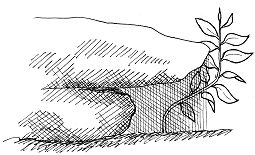What about those tomato plants on the windowsill, bending toward the sunlight? If shoots
are negatively geotropic, why don’t they grow straight up, no matter what the
direction of light? In many cases, a plant’s
phototropic and geotropic responses complement each other. If you plant a seed in
midsummer in full sunlight, the shoot will grow straight upward. Which phenomenon is
responsible for directing this growth? In this case, both geotropism and phototropism
would guide the shoot to grow vertically.
In other cases, the two phenomena work against each other.
For example, suppose a seed germinates in the shade of an overhanging rock. If the shoot
grows vertically, it will collide with the rock. Instead, the shoot will orient itself
toward the brightest light source. Once the shoot reaches the edge of the overhang, it
will reorient itself to grow vertically. As you can see, phototropism and geotropism are
both elements of the plant’s "guidance system."
Phototropism and Geotropism

|
|

Better bouquets
If you are in a windy spot, be sure to stake or otherwise prop up your cosmos,
scabiosa, and any other tall, top-heavy flowers. If the plants are blown over by the wind,
the stems will curve to grow upward—resulting in wavy or bent stems that are
difficult to arrange in a vase! |
|